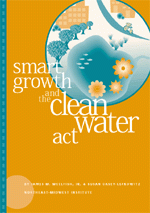
Land uses directly and indirectly affect the quality of our nation`s waters. Various patterns of urban, suburban, exurban, and rural development can contribute either to improving water quality or to impairing it. At the same time, state and federal programs directed at controlling water pollution can influence development. The relationship between land use and water quality has been studied on a watershed scale in a number of settings, but there has never been a study of the relationship between the programs of the federal Clean Water Act (CWA) and state and local land uses. This study examines the relationship of three CWA programs to patterns of land use and development. It addresses whether these programs encourage and enhance opportunities for "smart growth" or, conversely, lead to "sprawl." The study also identifies ways in which federal, state, and local governments can reduce compliance costs and increase environmental benefits through the mutually reinforcing components of smart growth strategies and CWA programs.